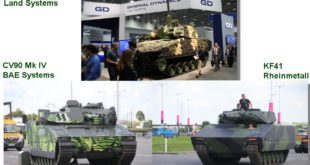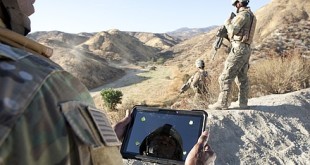The threats of chemical, biological, radiological, nuclear and explosive (CBRNE) hazards continue to advance. CBRN weapons are some of the most indiscriminate and deadly weapons in existence today, with capability to affect large population in wide geographical area and in short time. The release of Chemical, Biological, Radiological and Nuclear …
Read More »Militaries deploying unmanned tanks to strike drones, cruise missiles and ground targets and carry electronic warfare mission
Tank has been a mainstay of modern militaries, providing a unique capability of high lethality, protection and mobility. It’s heavy gun, can fire high explosive shells to destroy adversary’s tanks , it is heavily armored itself protecting crew from enemy fire and and it can move off roads since it …
Read More »Tungsten, the wonder military material used in armor-piercers, armored tanks, to Hypervelocity projectiles is controlled by China
Tungsten is one of the hardest metals on the earth, and many scientists compare it to diamond. Tungsten is a dull silver-colored metal with the highest melting point of any pure metal. Pure tungsten melts at a whopping 6,192 degrees F (3,422 degrees C) and won’t boil until temperatures reach …
Read More »3-D holograms will be employed for battlefield intelligence, military planning and explosives disposal
We see things because our eyes are sophisticated light detectors: they constantly capture the light rays bouncing off nearby objects so our brain can construct an ever-changing impression of the world around us. When our eyes see a three-dimensional image such as apple, Light reflects off the surface of the apple …
Read More »As melting ice bringing Arctic into geostrategic prominence, Russia quickly establishes its military dominance over it
The Arctic is currently a staggering 36 degrees warmer than normal at this time of year, according to information from the Danish Meteorological Institute. NASA report also shows that a vast region in the Arctic Ocean has gone missing and people from NASA think that the polar ice caps are …
Read More »US Army Optionally Manned Fighting Vehicle (OMFV) programme to replace its M-2 Bradley Infantry Fighting Vehicle (IFV)
The M-2 Bradley is an Infantry Fighting Vehicle (IFV) used to transport infantry on the battlefield and provide fire support to dismounted troops and suppress or destroy enemy fighting vehicles. The M-2 has a crew of three—commander, gunner, and driver—and carries seven fully equipped infantry soldiers. M-2 Bradley IFVs are …
Read More »Militaries adopting rugged 5G enabled Notebooks, tablets and smart phones into tactical operations, however their vulnerability requires secure solutions
Military is increasingly looking to commercial ICT devices like Smartphones and tablets and they are rapidly making their way into military operations. Mobility continues to transform how the Department of Defense (DoD) operates, connects, and supports its stakeholders – most significantly, through the use of commercial mobile solutions to provide …
Read More »Countries racing to develop Digital apps for giving military the warfighting edge
Recent growth and advances in mobile computing and communication have revolutionized the way we live and access information. Today we are able to receive and process a vast amount of real-time data and situational information on mobile devices in a manner that has not been witnessed previously. US Department …
Read More »Next generation Military Communications technologies enabling high-throughput mobile, secure, survivable, seamless, in congested and contested environments
Communications is vital for War fighters to exchange voice and data, command and control and situational awareness data and video. The vision of Communications area is to provide reliable communication from anywhere to everywhere from war fighters to supreme commander with demanded rate and least latency by exploiting complete electromagnetic …
Read More »Future Digital soldiers capabilities: Invisibility, Mind controlled Exoskeletons, Targeting lasers, Smart glasses, Wearable Biosensors, UAV equipped
In an era where technology is the key driver enhancing capabilities across the military, the soldier remains as crucial as ever for achieving mission success. Some of the missions the soldiers perform can take weeks, away from in difficult terrain like deserts and mountains which requires maintaining an incredibly high …
Read More » International Defense Security & Technology Your trusted Source for News, Research and Analysis
International Defense Security & Technology Your trusted Source for News, Research and Analysis









